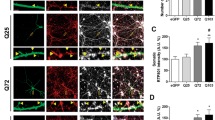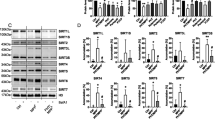Abstract
Sirt1, a NAD-dependent protein deacetylase, has emerged as a key regulator of mammalian transcription in response to cellular metabolic status and stress1. Here we show that Sirt1 has a neuroprotective role in models of Huntington's disease, an inherited neurodegenerative disorder caused by a glutamine repeat expansion in huntingtin protein (HTT)2. Brain-specific knockout of Sirt1 results in exacerbation of brain pathology in a mouse model of Huntington's disease, whereas overexpression of Sirt1 improves survival, neuropathology and the expression of brain-derived neurotrophic factor (BDNF) in Huntington's disease mice. We show that Sirt1 deacetylase activity directly targets neurons to mediate neuroprotection from mutant HTT. The neuroprotective effect of Sirt1 requires the presence of CREB-regulated transcription coactivator 1 (TORC1), a brain-specific modulator of CREB activity3. We show that under normal conditions, Sirt1 deacetylates and activates TORC1 by promoting its dephosphorylation and its interaction with CREB. We identified BDNF as a key target of Sirt1 and TORC1 transcriptional activity in both normal and Huntington's disease neurons. Mutant HTT interferes with the TORC1-CREB interaction to repress BDNF transcription, and Sirt1 rescues this defect in vitro and in vivo. These studies suggest a key role for Sirt1 in transcriptional networks in both the normal and Huntington's disease brain and offer an opportunity for therapeutic development.
This is a preview of subscription content, access via your institution
Access options
Subscribe to this journal
Receive 12 print issues and online access
$209.00 per year
only $17.42 per issue
Buy this article
- Purchase on Springer Link
- Instant access to full article PDF
Prices may be subject to local taxes which are calculated during checkout




Similar content being viewed by others
References
Haigis, M.C. & Guarente, L.P. Mammalian sirtuins–emerging roles in physiology, aging, and calorie restriction. Genes Dev. 20, 2913–2921 (2006).
Gatchel, J.R. & Zoghbi, H.Y. Diseases of unstable repeat expansion: mechanisms and common principles. Nat. Rev. Genet. 6, 743–755 (2005).
Conkright, M.D. et al. TORCs: transducers of regulated CREB activity. Mol. Cell 12, 413–423 (2003).
Pallos, J. et al. Inhibition of specific HDACs and sirtuins suppresses pathogenesis in a Drosophila model of Huntington's disease. Hum. Mol. Genet. 17, 3767–3775 (2008).
Parker, J.A. et al. Resveratrol rescues mutant polyglutamine cytotoxicity in nematode and mammalian neurons. Nat. Genet. 37, 349–350 (2005).
Cohen, D.E., Supinski, A.M., Bonkowski, M.S., Donmez, G. & Guarente, L.P. Neuronal SIRT1 regulates endocrine and behavioral responses to calorie restriction. Genes Dev. 23, 2812–2817 (2009).
Mangiarini, L. et al. Exon 1 of the HD gene with an expanded CAG repeat is sufficient to cause a progressive neurological phenotype in transgenic mice. Cell 87, 493–506 (1996).
Stack, E.C. et al. Chronology of behavioral symptoms and neuropathological sequela in R6/2 Huntington's disease transgenic mice. J. Comp. Neurol. 490, 354–370 (2005).
Bordone, L. et al. SIRT1 transgenic mice show phenotypes resembling calorie restriction. Aging Cell 6, 759–767 (2007).
Zala, D. et al. Progressive and selective striatal degeneration in primary neuronal cultures using lentiviral vector coding for a mutant huntingtin fragment. Neurobiol. Dis. 20, 785–798 (2005).
Subramanian, A. et al. Gene set enrichment analysis: a knowledge-based approach for interpreting genome-wide expression profiles. Proc. Natl. Acad. Sci. USA 102, 15545–15550 (2005).
Greenberg, M.E., Xu, B., Lu, B. & Hempstead, B.L. New insights in the biology of BDNF synthesis and release: implications in CNS function. J. Neurosci. 29, 12764–12767 (2009).
Chao, M.V., Rajagopal, R. & Lee, F.S. Neurotrophin signalling in health and disease. Clin. Sci. (Lond.) 110, 167–173 (2006).
Zuccato, C. et al. Loss of huntingtin-mediated BDNF gene transcription in Huntington's disease. Science 293, 493–498 (2001).
Tao, X., Finkbeiner, S., Arnold, D.B., Shaywitz, A.J. & Greenberg, M.E. Ca2+ influx regulates BDNF transcription by a CREB family transcription factor-dependent mechanism. Neuron 20, 709–726 (1998).
Jeong, H. et al. Acetylation targets mutant huntingtin to autophagosomes for degradation. Cell 137, 60–72 (2009).
Bittinger, M.A. et al. Activation of cAMP response element–mediated gene expression by regulated nuclear transport of TORC proteins. Curr. Biol. 14, 2156–2161 (2004).
Altarejos, J.Y. et al. The Creb1 coactivator Crtc1 is required for energy balance and fertility. Nat. Med. 14, 1112–1117 (2008).
Li, S., Zhang, C., Takemori, H., Zhou, Y. & Xiong, Z.Q. TORC1 regulates activity-dependent CREB-target gene transcription and dendritic growth of developing cortical neurons. J. Neurosci. 29, 2334–2343 (2009).
Dunah, A.W. et al. Sp1 and TAFII130 transcriptional activity disrupted in early Huntington's disease. Science 296, 2238–2243 (2002).
Zuccato, C. et al. Huntingtin interacts with REST/NRSF to modulate the transcription of NRSE-controlled neuronal genes. Nat. Genet. 35, 76–83 (2003).
Jiang, M. et al. Neuroprotective role of SIRT1 in mammalian models of Huntington's disease through activation of multiple SIRT1 targets. Nat. Med. advance online publication, doi:10.1038/nm.2558 (18 December 2011).
Cohen, E. & Dillin, A. The insulin paradox: aging, proteotoxicity and neurodegeneration. Nat. Rev. Neurosci. 9, 759–767 (2008).
Weydt, P. et al. Thermoregulatory and metabolic defects in Huntington's disease transgenic mice implicate PGC-1α in Huntington's disease neurodegeneration. Cell Metab. 4, 349–362 (2006).
Wu, Z. et al. Transducer of regulated CREB-binding proteins (TORCs) induce PGC-1α transcription and mitochondrial biogenesis in muscle cells. Proc. Natl. Acad. Sci. USA 103, 14379–14384 (2006).
Cui, L. et al. Transcriptional repression of PGC-1α by mutant huntingtin leads to mitochondrial dysfunction and neurodegeneration. Cell 127, 59–69 (2006).
Beal, M.F. Mitochondria and neurodegeneration. Novartis Found. Symp. 287, 183–192 (2007).
Wang, J. et al. The role of Sirt1: at the crossroad between promotion of longevity and protection against Alzheimer's disease neuropathology. Biochim. Biophys. Acta 1804, 1690–1694 (2010).
Zhao, W. et al. Peroxisome proliferator activator receptor γ coactivator-1α (PGC-1α) improves motor performance and survival in a mouse model of amyotrophic lateral sclerosis. Mol. Neurodegener. 6, 51 (2011).
Zheng, B. et al. PGC-1α, a potential therapeutic target for early intervention in Parkinson's disease. Sci. Transl. Med. 2, 52ra73 (2010).
Zhang, X. et al. Genome-wide analysis of cAMP-response element binding protein occupancy, phosphorylation, and target gene activation in human tissues. Proc. Natl. Acad. Sci. USA 102, 4459–4464 (2005).
Spandidos, A., Wang, X., Wang, H. & Seed, B. PrimerBank: a resource of human and mouse PCR primer pairs for gene expression detection and quantification. Nucleic Acids Res. 38, D792–D799 (2010).
Tiscornia, G., Singer, O. & Verma, I.M. Production and purification of lentiviral vectors. Nat. Protoc. 1, 241–245 (2006).
Sarbassov, D.D. et al. Rictor, a novel binding partner of mTOR, defines a rapamycin-insensitive and raptor-independent pathway that regulates the cytoskeleton. Curr. Biol. 14, 1296–1302 (2004).
Peng, J., Elias, J.E., Thoreen, C.C., Licklider, L.J. & Gygi, S.P. Evaluation of multidimensional chromatography coupled with tandem mass spectrometry (LC/LC-MS/MS) for large-scale protein analysis: the yeast proteome. J. Proteome Res. 2, 43–50 (2003).
Yates, J.R. III, Eng, J.K., McCormack, A.L. & Schieltz, D. Method to correlate tandem mass spectra of modified peptides to amino acid sequences in the protein database. Anal. Chem. 67, 1426–1436 (1995).
Tabb, D.L., McDonald, W.H. & Yates, J.R. III. DTASelect and Contrast: tools for assembling and comparing protein identifications from shotgun proteomics. J. Proteome Res. 1, 21–26 (2002).
MacCoss, M.J., Wu, C.C. & Yates, J.R. III. Probability-based validation of protein identifications using a modified SEQUEST algorithm. Anal. Chem. 74, 5593–5599 (2002).
Gao, J. et al. A novel pathway regulates memory and plasticity via SIRT1 and miR-134. Nature 466, 1105–1109 (2010).
Acknowledgements
We thank M. Montminy (Peptide Biology Laboratories (PBL), Salk Institute) for the Flag-CREB, Flag-TORC1 and Flag-TORC1 S151A plasmids and for antibody to TORC1 (#6937, PBL, Salk Institute) and helpful discussions; M.E. Greenberg (Harvard Medical School) for the pIII(170)Luc plasmid15; T. Kouzarides (University of Cambridge) for Sirt1 and Sirt1 HY plasmids; Z. Wu (Novartis Institutes for Biomedical Research) for the TORC1 plasmid; M. Difiglia (Massachusetts General Hospital) for antibody to HTT (Ab1); E. Regulier (Novartis Institutes for Biomedical Research) for lentiviral vectors expressing HTTEx1-25Q, HTTEx1-72Q and Sirt1; and J.M. Park (Massachusetts General Hospital) for the lentiviral vector used for CREB knockdown. We also acknowledge C. Whitaker (Massachusetts Institute of Technology) for analysis of the microarray data. This work was supported by grant R01NS051303 from the US National Institutes of Health (D.K.); the Cure Huntington's Disease Initiative (CHDI), Hereditary Disease Foundation (HDF) (D.E.C.); US National Institutes of Health, Glenn Foundation for Medical Research (L.G.) and grants R01MH067880-08 and P41RR011823-15 from the US National Institutes of Health (J.R.Y.).
Author information
Authors and Affiliations
Contributions
H.J. performed the experiments shown in Figures 2, 3, 4 and Supplementary Figures 4, 6 and 9–13. D.E.C. and A.S. performed the experiments shown in Figures 1a, 1e, 2c and 2d and Supplementary Figures 1 and 5. L.C. performed the experiments shown in Figure 1b–h and Supplementary Figures 13 and 14. J.R.M. helped with the experiments shown in Figure 4f. J.N.S. and J.R.Y. performed the experiments shown in Supplementary Figure 7. L.B. performed the experiments shown in Supplementary Figure 2. L.P.G. and D.K. provided the conceptual framework for the study and discussed the results. D.K. and H.J. wrote the paper.
Corresponding author
Ethics declarations
Competing interests
L.P.G. is a member of the Scientific Advisory Board of Sirtris, GlaxoSmithKline.
Supplementary information
Supplementary Text and Figures
Supplementary Figures 1–14 and Supplementary Methods (PDF 1220 kb)
Rights and permissions
About this article
Cite this article
Jeong, H., Cohen, D., Cui, L. et al. Sirt1 mediates neuroprotection from mutant huntingtin by activation of the TORC1 and CREB transcriptional pathway. Nat Med 18, 159–165 (2012). https://doi.org/10.1038/nm.2559
Received:
Accepted:
Published:
Issue Date:
DOI: https://doi.org/10.1038/nm.2559
This article is cited by
-
The role of SIRT1 level and SIRT1 gene polymorphisms in optic neuritis patients with multiple sclerosis
Orphanet Journal of Rare Diseases (2023)
-
Activated SIRT1 contributes to DPT-induced glioma cell parthanatos by upregulation of NOX2 and NAT10
Acta Pharmacologica Sinica (2023)
-
Nicotine rebalances NAD+ homeostasis and improves aging-related symptoms in male mice by enhancing NAMPT activity
Nature Communications (2023)
-
The Combination of Citicoline and Nicotinamide Mononucleotide Induces Neurite Outgrowth and Mitigates Vascular Cognitive Impairment via SIRT1/CREB Pathway
Cellular and Molecular Neurobiology (2023)
-
mGluR5 ablation leads to age-related synaptic plasticity impairments and does not improve Huntington’s disease phenotype
Scientific Reports (2022)



